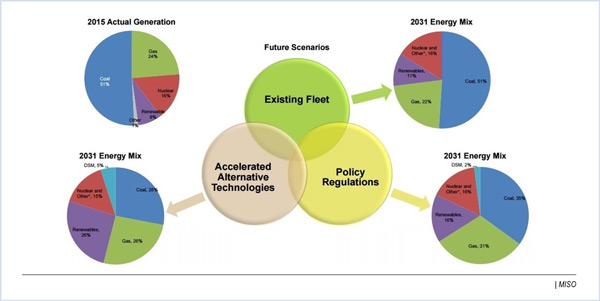By Amanda Durish Cook
MISO’s three-year effort to identify long-term transmission needs started last week with the RTO gathering stakeholders to explain the data that will inform the study.

The regional transmission overlay study will identify new transmission needed to accommodate MISO’s shifting resource mix.
“MISO has been experiencing a significant resource change for quite some time now. … We’re just starting to get our hands around the magnitude of the needs,” Lynn Hecker, MISO manager of expansion planning, said at a special Jan. 31 workshop of the Economic Planning Users Group, the first of four scheduled to take place in 2017. “At the end of the day, the goal is to have the most cost-effective and efficient solution for our footprint to benefit our consumers.”
Hecker said MISO is very early into its study and has not made any conclusions about which or how many projects will be recommended. She said 2017 will be used to identify system needs, and project candidates would not be revealed until 2018 or 2019.
Three Futures
MISO will develop long-term transmission roadmaps for each of three 15-year futures from its 2017 Transmission Expansion Plan: an “existing fleet” future with limited changes and no modeled carbon cap; a “policy regulations” future in which federal rules drive a 25% reduction in carbon emissions; and an “accelerated alternative technologies” future in which innovations in renewables foster a 35% carbon emissions reduction.

It will also consider other factors, such as the top 30 congested flowgates, forecasted differences in LMPs, production cost savings, and constrained energy sources and sinks to identify new transmission corridors. (See “Long-Term Overlay Study Scoped; MISO Asks for More Responses,” MISO Planning Advisory Committee Briefs.)
Stakeholders asked if MISO planned to use MTEP 17 futures for all three years of the study. Hecker said there would be an annual refresh of futures and weights to inform the study. “That’s where we are going to be able to capture any potential changes,” she said.
Hecker said it is likely that MTEP 17 futures will be used, even with the Trump administration’s plan to abandon the Paris Agreement on climate change and EPA’s Clean Power Plan. “We don’t expect to see very drastic changes in 2017 versus 2018 futures,” she said.
It’s still undecided if MTEP 17 futures will be reweighted with less emphasis on a policy regulations future. The issue is expected to be discussed at the February Planning Advisory Committee meeting. (See MISO Stakeholders Seek Review of MTEP Futures Under Trump.)
MISO Director of Regional and Economic Studies John Lawhorn said that by 2031, the RTO expects gas prices to hover around $7.50/MMBtu, with:
- Between 5 GW of renewable additions under an “existing fleet” future to 52 GW in an “accelerated alternative technologies” future;
- Coal generation retirements of 8 GW to 24 GW under the same scenarios;
- An increase in solar capacity from 180 MW in 2016 to 4,938 MW by 2021; and
- An increase in wind capacity from 16,319 MW in 2016 to 23,554 MW in 2021.
Move from Inventory-Based Generation
“We’re going from inventory-based sources of energy [like coal piles and natural gas storage] to non-inventory. We want to make sure we meet system needs both on a reliability and economic basis,” Lawhorn said. “Our generation interconnection queue is full of intermittents and continues to grow.”
Consultant Roberto Paliza of Indianapolis expressed concern that MISO might overlook some transmission solutions if it only relies on the megawatt limit in MISO and SPP’s contract path in modeling, which is in place until 2021. MISO staff pointed out the transmission overlay study is one of three MISO studies currently in progress that could identify a project to expand the transfer capability between MISO North and South. (See “Studies Could Assist in Relieving North-South Constraint,” MISO Planning Advisory Committee Briefs.)
MISO Policy Studies Engineer Matt Ellis said the economic benefit of load diversity — taking advantage of different areas peaking at different times — could be expanded beyond the RTO’s borders to include capacity exchanges with neighboring systems.
“If you can connect pockets of renewables across regions, you can make those resources look not so intermittent anymore,” Ellis said.
Ellis said he was only introducing the idea and that MISO would conduct discussions on how a load diversity analysis could work into the transmission overlay. He said while MISO could expand peak load obligations exchanges into the Eastern Interconnection, the RTO could also exchange capacity with the Western Interconnection if DC line upgrades are made. MISO estimated that load diversity could save it $4 billion per year.
Sam Gomberg, an energy analyst in the Midwest office of the Union of Concerned Scientists, asked if MISO sufficiently explored its own load diversity before looking outside the footprint. Ellis said the benefits of load diversity within MISO were already being realized with a reduced planning reserve margin.
An afternoon portion of the workshop, at which MISO and stakeholders discussed thermal constraint locations covered by Critical Energy Infrastructure Information (CEII) rules, was not open to the public. Stakeholders representing MISO’s North, Central/East, South and West regions split by region to discuss potential transmission needs. Bill Booth of the Mississippi Public Service Commission said his commission did not have access to CEII but still wanted in on the conversation.
Hecker said most study results would be made public, but detailed transmission maps with current bus and transmission line locations will not be posted publicly.
Lawhorn stressed the three-year study will be peppered with stakeholder opportunities to weigh in.




